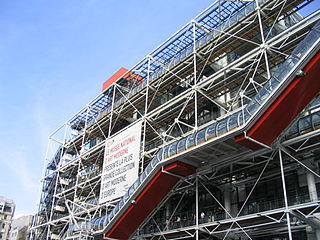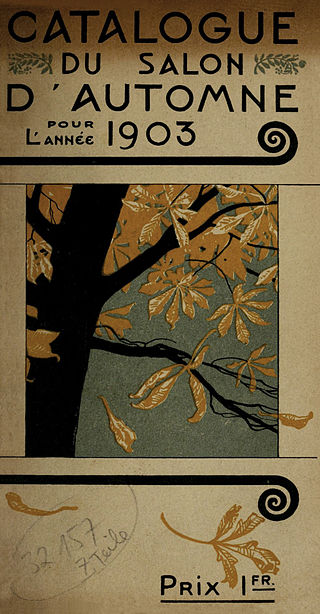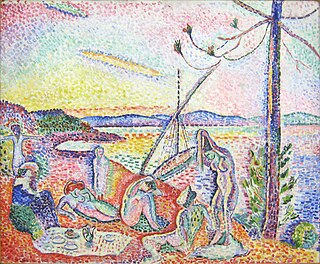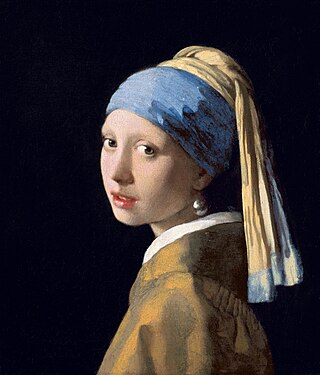Related Research Articles

Georges Braque was a major 20th-century French painter, collagist, draughtsman, printmaker and sculptor. His most notable contributions were in his alliance with Fauvism from 1905, and the role he played in the development of Cubism. Braque's work between 1908 and 1912 is closely associated with that of his colleague Pablo Picasso. Their respective Cubist works were indistinguishable for many years, yet the quiet nature of Braque was partially eclipsed by the fame and notoriety of Picasso.

Cubism is an early-20th-century avant-garde art movement that revolutionized European painting and sculpture, and inspired related artistic movements in music, literature, and architecture. In Cubist works of art, the subjects are analyzed, broken up, and reassembled in an abstract form—instead of depicting objects from a single perspective, the artist depicts the subject from multiple perspectives to represent the subject in a greater context. Cubism has been considered the most influential art movement of the 20th century. The term cubism is broadly associated with a variety of artworks produced in Paris or near Paris (Puteaux) during the 1910s and throughout the 1920s.

New materials in 20th-century art were introduced to art making from the very beginning of the century. The introduction of new materials and heretofore non-art materials helped drive change in art during the 20th century. Traditional materials and techniques were not necessarily displaced in the 20th century. Rather, they functioned alongside innovations that came with the 20th century. Such mainstays as oil-on-canvas painting, and sculpting in traditional materials continued right through the 20th century into the 21st century. Furthermore, even "traditional" materials were greatly expanded in the course of the 20th century. The number of pigments available to artists has increased both in quantity and quality, by most reckoning. New formulations for traditional materials especially the commercial availability of acrylic paint have become widely used, introducing initial issues over their stability and longevity.

Modern art includes artistic work produced during the period extending roughly from the 1860s to the 1970s, and denotes the styles and philosophies of the art produced during that era. The term is usually associated with art in which the traditions of the past have been thrown aside in a spirit of experimentation. Modern artists experimented with new ways of seeing and with fresh ideas about the nature of materials and functions of art. A tendency away from the narrative, which was characteristic of the traditional arts, toward abstraction is characteristic of much modern art. More recent artistic production is often called contemporary art or postmodern art.

The Musée National d'Art Moderne is the national museum for modern art of France. It is located in Paris and is housed in the Centre Pompidou in the 4th arrondissement of the city. In 2021 it ranked 10th in the list of most visited art museums in the world, with 1,501,040 visitors. It is one of the largest museums for modern and contemporary art.

The Salon d'Automne, or Société du Salon d'automne, is an art exhibition held annually in Paris. Since 2011, it is held on the Champs-Élysées, between the Grand Palais and the Petit Palais, in mid-October. The first Salon d'Automne was created in 1903 by Frantz Jourdain, with Hector Guimard, George Desvallières, Eugène Carrière, Félix Vallotton, Édouard Vuillard, Eugène Chigot and Maison Jansen.

The Société des Artistes Indépendants or Salon des Indépendants was formed in Paris on 29 July 1884. The association began with the organization of massive exhibitions in Paris, choosing the slogan "sans jury ni récompense". Albert Dubois-Pillet, Odilon Redon, Georges Seurat and Paul Signac were among its founders. For the following three decades their annual exhibitions set the trends in art of the early 20th century, along with the Salon d'Automne. This is where artworks were often first displayed and widely discussed. World War I brought a closure to the salon, though the Artistes Indépendants remained active. Since 1920, the headquarters has been located in the vast basements of the Grand Palais.

Les Demoiselles d'Avignon is a large oil painting created in 1907 by the Spanish artist Pablo Picasso. Part of the permanent collection of the Museum of Modern Art in New York, it portrays five nude female prostitutes in a brothel on Carrer d'Avinyó, a street in Barcelona, Spain. The figures are confrontational and not conventionally feminine, being rendered with angular and disjointed body shapes, some to a menacing degree. The far left figure exhibits facial features and dress of Egyptian or southern Asian style. The two adjacent figures are in an Iberian style of Picasso's Spain, while the two on the right have African mask-like features. Picasso said the ethnic primitivism evoked in these masks moved him to "liberate an utterly original artistic style of compelling, even savage force” leading him to add a shamanistic aspect to his project.
Sidney Janis was a wealthy clothing manufacturer and art collector who opened an art gallery in New York in 1948. His gallery quickly gained prominence, for he not only exhibited work by the Abstract Expressionists, but also European artists such as Pierre Bonnard, Paul Klee, Joan Miró, and Piet Mondrian. As the critic Clement Greenberg explained in a 1958 tribute to Janis, the dealer's exhibition practices had helped to establish the legitimacy of the Americans, for his policy "not only implied, it declared, that Jackson Pollock, Willem de Kooning, Franz Kline, Phillip Guston, Mark Rothko, and Robert Motherwell were to be judged by the same standards as Matisse and Picasso, without condescension, without making allowances." Greenberg observed that in the late 1940s "the real issue was whether ambitious artists could live in this country by what they did ambitiously. Sidney Janis helped as much as anyone to see that it was decided affirmatively."
Taschen Basic Art is a best selling art collection books, published by Taschen, starting in 1985. Each book looks at a different artist, with a biography, and illustrations of their work. The books are published as affordable hardcover books of 21 x 26 cm. As of 2022, 78 titles had been published. Similar series entitled Taschen Basic Architecture, Taschen Basic Cinema and Taschen Basic Photographies were started after the success of the Basic Art series.
Twentieth-century art—and what it became as modern art—began with modernism in the late nineteenth century.

The history of Western painting represents a continuous, though disrupted, tradition from antiquity until the present time. Until the mid-19th century it was primarily concerned with representational and traditional modes of production, after which time more modern, abstract and conceptual forms gained favor.

Michael Bidlo is an American conceptual artist who employs painting, sculpture, drawing, performance, and other forms of "social sculpture."

20th-century Western painting begins with the heritage of late-19th-century painters Vincent van Gogh, Paul Cézanne, Paul Gauguin, Georges Seurat, Henri de Toulouse-Lautrec, and others who were essential for the development of modern art. At the beginning of the 20th century, Henri Matisse and several other young artists including the pre-cubist Georges Braque, André Derain, Raoul Dufy and Maurice de Vlaminck, revolutionized the Paris art world with "wild", multi-colored, expressive landscapes and figure paintings that the critics called Fauvism. Matisse's second version of The Dance signified a key point in his career and in the development of modern painting. It reflected Matisse's incipient fascination with primitive art: the intense warm color of the figures against the cool blue-green background and the rhythmical succession of the dancing nudes convey the feelings of emotional liberation and hedonism.

Fauvism is a style of painting and an art movement that emerged in France at the beginning of the 20th century. It was the style of les Fauves, a group of modern artists whose works emphasized painterly qualities and strong colour over the representational or realistic values retained by Impressionism. While Fauvism as a style began around 1904 and continued beyond 1910, the movement as such lasted only a few years, 1905–1908, and had three exhibitions. The leaders of the movement were André Derain and Henri Matisse.

Cubist sculpture developed in parallel with Cubist painting, beginning in Paris around 1909 with its proto-Cubist phase, and evolving through the early 1920s. Just as Cubist painting, Cubist sculpture is rooted in Paul Cézanne's reduction of painted objects into component planes and geometric solids; cubes, spheres, cylinders, and cones. Presenting fragments and facets of objects that could be visually interpreted in different ways had the effect of 'revealing the structure' of the object. Cubist sculpture essentially is the dynamic rendering of three-dimensional objects in the language of non-Euclidean geometry by shifting viewpoints of volume or mass in terms of spherical, flat and hyperbolic surfaces.

Proto-Cubism is an intermediary transition phase in the history of art chronologically extending from 1906 to 1910. Evidence suggests that the production of proto-Cubist paintings resulted from a wide-ranging series of experiments, circumstances, influences and conditions, rather than from one isolated static event, trajectory, artist or discourse. With its roots stemming from at least the late 19th century, this period is characterized by a move towards the radical geometrization of form and a reduction or limitation of the color palette. It is essentially the first experimental and exploratory phase of an art movement that would become altogether more extreme, known from the spring of 1911 as Cubism.

The Goulandris Museum of Contemporary Art is a modern art museum in Eratosthenous Street, Pangrati, Athens, Greece, opened in October 2019. It displays many of the works amassed by shipowner Basil Goulandris and his wife Elise Karadontis, who died in 1994 and 2000 respectively, with an art collection valued at US$3 billion.
References
- 1 2 "Pegram [née Woods], Lorna Gladys Hurst (1926–1993), television producer and novelist" . Oxford Dictionary of National Biography (online ed.). Oxford University Press. 2004. doi:10.1093/ref:odnb/53134 . Retrieved 3 October 2020.(Subscription or UK public library membership required.)
- 1 2 "The Shock of the New". www.bbc.com. Retrieved 3 October 2020.
- ↑ Episode guide
- ↑ The Shock of the New on PBS
- ↑ "Robert Hughes on updating The Shock of the New". The Guardian . 30 June 2004. Archived from the original on 19 April 2023.
- ↑ "BBC Two - the Shock of the New - Episode guide".
- ↑ Hughes, Robert (1980). The Shock of the New. British Broadcasting Corporation. p. 200. ISBN 0-563-17780-2.
- ↑ Hughes, Robert (1981). The Shock of the New: Art and the Century of Change. ISBN 0-500-27582-3.
- ↑ The Shock of the New on Youtube.
- ↑ "The Shock of the New on Vimeo". Archived from the original on 8 December 2015. Retrieved 5 December 2015.
- ↑ The Shock of the New on DVD. BBC and Time Life Films. Ambrose Video